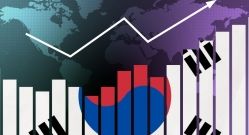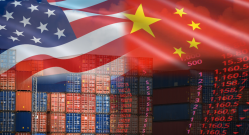
What America is telling us about its strategy
The National Security Strategy paper recently published by the White House offers the same assessment of the current period as Vladimir Putin shared at the Valdai Discussion Club: America is talking about a “crucial decade” and Russia a “dangerous decade”.
Whatever geopolitical events may lie ahead, whether periods of calm or strategic U-turns that take us by surprise, businesses and financial markets must ultimately take a long-term view of geopolitics. To reinforce this point, whatever our aspirations about strategic independence, we must not be naive about how long this will take: it takes years to secure value chains and reindustrialise.
Even if globalisation is reorganised, we’re still interdependent
We will thus continue to operate for some time to come as part of a “complex” global system – i.e. a system in which no player is independent of other players, and where each and every shock can have multiple powerful and far-reaching direct effects and side-effects. Since the advent of Covid and the war in Ukraine, this can no longer be denied: every crisis – whether economic, environmental or political – has the potential to be systemic and can quickly radiate out across all dimensions and geographies, distorting prices and disrupting supply and demand. And our now more realistic collective awareness of the systemic way the world operates is increasingly bearing on the decisions made by governments, businesses and individuals concerned about security, resilience, savings and storage. In short, what economists call agents’ preferences are undergoing a profound change.
Lastly, we know that this system has moved into a state of disequilibrium1 that is affecting every area, from the environment, economics, politics and geopolitics right through to cognition (the much talked about meaning crisis). Now, like all complex systems studied by physics and chaos theory, this state of disequilibrium yields bifurcation points, which are also points of acceleration – i.e. times when major events rapidly unfold one after the other, profoundly shaping the emerging scenario.
This complex mechanics is very helpful when trying to understand today’s geopolitics, where the current bifurcation is being shaped both by disruptive events (war; change of government in a power central to the scenario, China first and foremost2) and by less visible shifts of power (similar to the effects of plate tectonics) but in all areas of power at once, affecting both hard and soft power as well as the ability to produce standards and, above all, new values and new models of society. This bifurcation point means the geopolitical reconfiguration is now accelerating. However, we must be careful not to oversimplify: this is a long-term process involving multiple players, so there is still all to play for. Only one thing is certain: it’s vital to adopt prudent positions, not make any geopolitical bets and, amid the fog of events, diversify your risks.
Accelerating technological containment, or the old anaconda strategy
Bifurcation points like these are times when players take important decisions because they sense just how much the choices they make today will affect their power tomorrow. This is precisely what the White House’s recent National Security Strategy confirms. Some elements of the paper are illuminating with regard to our own future:
- The paper talks about a “decisive decade” in terms of the capacity to “reshape the international order”. We must act, and quickly. But to what end? The answer is clear: to build up competitive advantages in the areas of power referenced in the document, such as microelectronics, semiconductors, quantum computing, artificial intelligence, biotechnologies, clean energy and advanced telecommunications.
- For America, then, the goal is no longer to maintain a technological lead of two or three generations, as was the case under a globalisation that was simply competitive but not conflictual, but to prevent powers seen as hostile from accessing technologies critical to amassing geopolitical power. America is thus stepping up its strategy of containing China’s access to semiconductors, extending its ban so it affects not just businesses but all US citizens in contact with Beijing in this sector.
- The war for technological dominance has thus become so important that it can even be waged at the immediate expense of the economy, even if this causes the share prices of western companies in the sector to briefly nosedive.
The geopoliticisation of the economy, or the haunting spectre of the Manhattan Project
We then read that the US will be pursuing a 360-degree strategy – i.e. a strategy that spans all sectors and all countries. “[W]e have broken down the dividing line between foreign policy and domestic policy […], we must proactively shape the international order in line with our interests and values […]. We must complement the innovative power of the private sector with a modern industrial strategy that makes strategic public investments in America’s workforce, and in strategic sectors and supply chains, especially critical and emerging technologies […]”. What we have here is the American DNA of a war economy that emerged at the time of the Manhattan Project and has left its indelible mark on public-private collaboration in America. It is this that will constrain the economy and politics in all strategic areas, the scope of which is steadily widening. Industrial policy is back in the ascendancy, and while this is admittedly due in part to climate transition, it is also driven by the reaffirmed goal of US leadership: although America recognises that the international environment is more contested than it was, it still sees itself as “the world’s leading power” and believes that “our inherent national strengths […] remain unparalleled”.
Accelerating ideological warfare
America’s programme for leadership officially rests on three pillars (to which we can obviously add the dollar and universities): technological leadership, military supremacy and a network of alliances (particularly in technology and manufacturing). These pillars are united around two ideas: first, that China is the only real competitor; and second, that the US is the only legitimate leader (“the world needs us”) of a camp made up of democracies and “other like-minded states” as well as regimes that recognise the rules-based international order, as opposed to the camp of autocratic powers bent on overthrowing the world order, chief among them China, Russia, Iran and North Korea.
This point has many operational implications for businesses, since it touches on the issues of respect for territorial integrity, the organisation of cyberspace and freedom of navigation. The issue is whether we are going to be confronted with multiple more or less watertight normative spaces. Also, will current conflicts be resolved on the basis of a rules-based order (which revisionist states no longer accept) or through lengthy negotiations aimed at striking a regional balance of powers acceptable to all players, along the lines of the Congress of Vienna? This is the problem in Ukraine, the Caucasus, North and South Korea, and so on.
However, the US Government denies laying the foundations for another Cold War and emphasises the fact that various common challenges – notably in relation to the climate – will force a degree of collaboration. Nevertheless, in light of this paper and political developments in China, it is clear just how pivotal the ideological clash is likely to be. From the US perspective, it’s a clash between democracies and authoritarian regimes. Seen from Beijing and Moscow, it’s a war of “others” against a West whose oft-denounced double standards they are no longer prepared to tolerate.
Don’t strangle Europe to resuscitate NATO
While this US strategy is already making its mark in a number of sectors, it is also coming up against some sizeable pitfalls, some of them within its own camp. The first is becoming increasingly stark in Europe: the US is going to have to find the right balance between strengthening the Atlantic alliance and suffocating Europe, where political centrifugal forces, fuelled by economic difficulties, are gaining the upper hand. Following the moment of unity against Moscow, there are increasing signs of fragmentation in the European Union, ranging from the difficulty of arriving at a shared position on gas and electricity prices through to the unusually intense disagreement within the Franco-German “couple”. Resuscitating NATO does not mean strangling Europe. For America, whose grand strategy relies on strong alliances, this would be a serious unwanted side-effect of the conflict in Ukraine.
The Indo-Pacific: epicentre of 21st-century geopolitics
The second pitfall is also linked to the war: US public opinion is changing and support for the conflict is flagging. According to a recent Pew Research poll, 32% of Republicans think the US is giving Ukraine too much support, up from 9% in March. If the Republicans manage to tip the balance of power in the midterm elections, calls for a negotiated settlement will undoubtedly intensify, which will be increasingly at odds with the rhetoric of a war against illiberal faux democracies. This domestic political situation could thus prompt US strategic reversals: let’s not forget that, for America, the number one enemy is China, and this idea is one of the few points around which there is bipartisan agreement, supported by increasingly hostile public opinion towards Beijing (with the percentage of Americans having a negative opinion on China up from 35% in 2004 to 82% in 2021).
This kind of hostility between peoples has a profound influence on the overall scenario: it is the most durable foundation for geopolitical tensions. Once again, it’s vital to take a long-term view here. In South Korea, the percentage of negative opinions of China has risen from 31% to 80% in 20 years. It has even risen as high as 86% in Japan and 87% in Australia. Asia is, politically speaking, completely polarised, and the paper emphasises – no doubt rightly – that the Indo-Pacific region will be the “epicentre of 21st-century geopolitics”.
The gap between words and reality
Lastly, the final pitfall for America is the world beyond Europe and allied Asia, in places like Turkey, India and the Gulf states. In that world, which is neither completely friendly nor completely hostile, America’s leadership is far from obvious. The only way it will be possible to forge alliances is on the basis of a rules-based international order, but not of democracy. In the US National Security Strategy, the section on the Middle East prudently relegates to the background the principle that the US administration will continue to defend democracy – a principle at the heart of its stance on China. Here again, the war has had side-effects that Uncle Sam has a hard time controlling: various “secondary” actors have gained increased strategic independence, and Russia’s ongoing links with Turkey, India, Saudi Arabia and the United Arab Emirates have forced the US to adopt a more pragmatic stance. Examples abound daily, from Indian purchases of Russian oil through to Saudi Arabia’s decision to cut production within the framework of OPEC+, not forgetting Mohamed bin Zayed Al Nahyan’s trip to Moscow and effort to rehabilitate Syria’s President Assad by inviting him to the Emirates. All these affirmations of independence and power are confusing the picture!
In reality, the US has reforged alliances in some regions, while stakeholder autonomy and à la carte agreements have prevailed in many others. In many parts of the world, it will be no easy task for America to implement the National Security Strategy set out in this paper.
Notes
1 See Geopolitics – Time for choices, Tania Sollogoub, September 2022.
2 See article China: release of growth figures fails to quell market fears.











